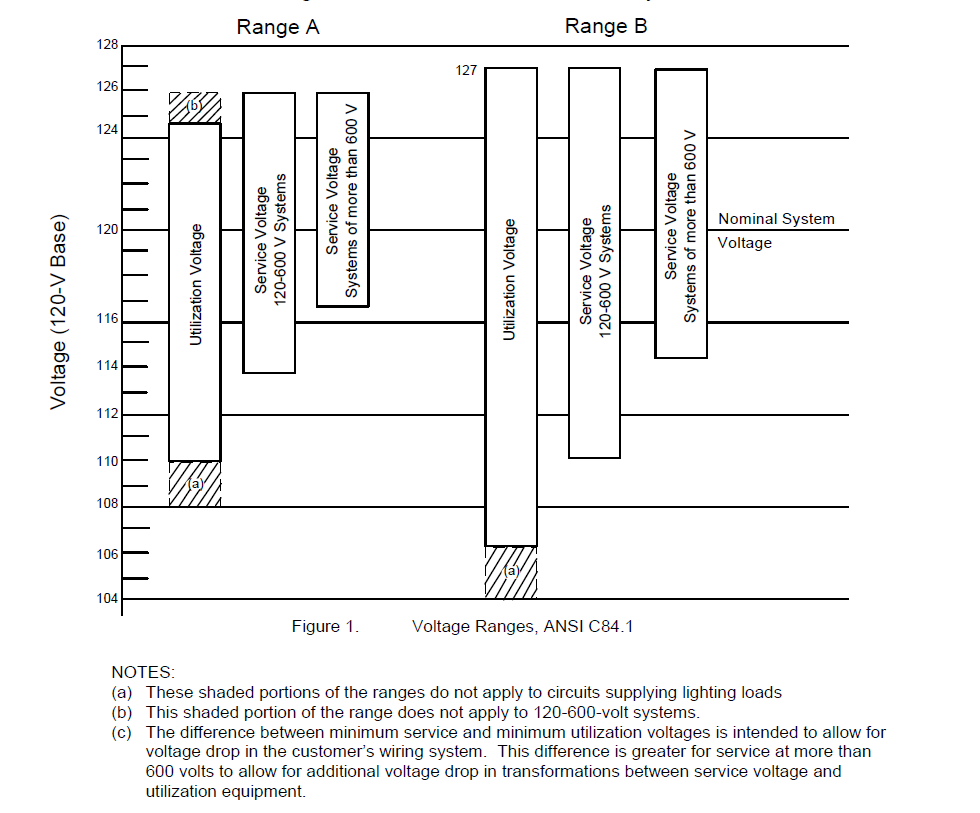The national standard for utility voltage tolerance in North America is ANSI C84.1. This standard establishes nominal voltage ratings and operating tolerances for 60Hz electric power systems above 100 volts. This standard includes preferred voltage ratings up to and including 1,200kV maximum system voltage. The voltage on a utility feeder changes depending on the loading on the line, the reactive power demand of the load, time of the day and many other factors. Utilities regulate the system voltage by switching power factor correction capacitors, tap changing transformers, voltage regulators, shunt reactors to name a few. The switching of these voltage regulating devices is not instantaneous and usually there is a delay of several minutes for voltage correction to happen.
ANSI C84.1 establishes nominal voltage ratings for utilities to regulate and it also establishes voltage tolerance at the facility load equipment. Voltage variation over the course of a time, season, loading is something that the utilities and customer have to tolerate. However, it is possible to design a power system that should work seamlessly across all possible excursions of the voltage as defined in the standard. ANSI C84.1 provides this tolerance band for the service entrance voltage or the service voltage and the utilization voltage or the voltage at the point of use.
Service Voltage: Voltage at the electric utility service. In distribution systems this is usually considered the voltage at the meter socket or entrance switch.
Utilization Voltage: Voltage at the end user load. This is generally considered to be the voltage at the terminals of the device or appliance or the voltage at the convenience outlet to which these terminals are connected. This voltage is the facilities responsibility.
Service voltage requirements are tighter than utilization voltage as the standard allows for some voltage drop within a facility.
It should be noted that the voltage tolerance is for sustained voltage and not momentary voltage variation due to switching or fault etc. The ANSI C84.1 voltage tolerance graph is provided below. It can be noted that two ranges are provided. Range A and Range B.

ANSI C84.1
Range A: Range A provides the normally expected voltage tolerance on the utility supply for a given voltage class. Variations outside the range should be infrequent. The utilization equipment (loads) are expected to function and provide full satisfactory performance for range A voltage tolerance.
-
Service Voltage: It is expected that most service voltage variation occurs within this range. The occurrence of service voltage variation outside this range should be infrequent. For range A this variation of allowable service voltage is +5% to -5% for system operating 600V and below. For systems operating above 600V this range is +5% to -2.5%.
-
Utilization Voltage: End user equipment should be designed to operate effectively and to provide full performance within the limits of range A service voltage. The tolerance for range A utilization voltage is +5% to -10%.
Range B: Range B provides voltage tolerances above and below range A limits that necessarily result from practical design and operating conditions on supply or user systems or both. These conditions should be limited in extent, frequency and duration. When these variations occur, measures should be taken within a reasonable time frame to get back to range A.
-
Service Voltage: For range B this variation of allowable service voltage is +5.8% to -8.3% for system operating 600V and below. For systems operating above 600V this range is +5.8% to -5%.
-
Utilization Voltage: End user equipment should be designed to provide acceptable performance for voltages in range B, although not necessarily as good performance as in range A. The tolerance for range B utilization voltage is +5.8% to -13.3%.
The following selector can be used to get the range A voltage tolerances for common Low Voltage systems.
The following selector can be used to get the range A voltage tolerances for common Medium Voltage systems.
It is recognized that due to conditions beyond the control of supplier, user or both there will be periods when the voltages are outside range B limits. Utilization equipment may not operate under such conditions and protective devices may operate to protect the equipment. When voltages occur outside the limits of range B, prompt corrective action shall be taken. The urgency for such action will depend on many factors, such as the location and nature of the loads or circuits involved, and the magnitude and duration of the deviation beyond range B limits (ANSI C84.1-2006).
